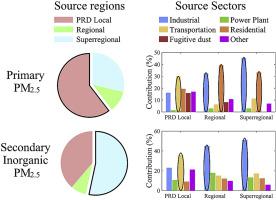Environmental Pollution ( IF 7.6 ) Pub Date : 2020-09-11 , DOI: 10.1016/j.envpol.2020.115418 Wenyi Yang , Huansheng Chen , Jianbin Wu , Wending Wang , Junyu Zheng , Duohong Chen , Jie Li , Xiao Tang , Zifa Wang , Lili Zhu , Wei Wang

|
Fine particulate matter (PM2.5) contains both primary and secondary components, and their source apportionment characteristics in the Pearl River Delta (PRD) region during 2015 were compared by applying an air quality model coupled with an on-line tracer-tagged module. The results of contributions from different source regions to primary PM2.5 (PPM2.5) and secondary inorganic PM2.5 (SIPM2.5) in four selected cities show that the effect of regional transport on the SIPM2.5 level is stronger than that on the PPM2.5 level in the PRD region. For both Guangzhou city and the average of the entire PRD region, the industrial (25-40%) and transportation (20-25%) sectors are major sources of PPM2.5 and SIPM2.5. However, the residential sector contributes approximately 25% to the PPM2.5 level, mainly from residential biomass burning, but accounts for only approximately 10% of the SIPM2.5 level. The relative importance of each sector to the contributions from local and regional transport indicates that industrial emissions appear to lead to regional air pollution, while the transportation emissions seem to mainly affect the local and surrounding areas. Considering the impact of regional contributions to air quality, efforts made to reduce emissions in each city could not only improve the local air quality but also benefit downstream regions. To further decrease the PM2.5 level, the local government of each city in the PRD region should not only continue to strengthen the control of local emissions, such as those from transportation and residential biomass burning, but also increase their focus on regional joint prevention and control strategies with upstream area (such as northern Guangdong Province, and Jiangxi, Fujian and Hunan provinces).
中文翻译:

数值模拟珠江三角洲地区2015年一次和二次无机PM 2.5的源分配特征
细颗粒物(PM 2.5)包含主要成分和次要成分,并通过应用空气质量模型和在线示踪标签模块,比较了2015年珠江三角洲(PRD)地区的源分配特征。不同来源地区对四个选定城市的初级PM 2.5(PPM 2.5)和次级无机PM 2.5(SIPM 2.5)的贡献结果表明,区域交通对SIPM 2.5的影响要强于对PPM 2.5的影响在珠三角地区。对于广州市和整个珠三角地区的平均而言,工业(25-40%)和交通运输(20-25%)是PPM 2.5和SIPM 2.5的主要来源。但是,住宅部门对PPM 2.5的贡献约为25%,主要来自住宅生物质燃烧,但仅占SIPM 2.5的约10%。水平。每个部门对本地和区域运输贡献的相对重要性表明,工业排放似乎导致区域空气污染,而运输排放似乎主要影响本地和周边地区。考虑到区域对空气质量的影响,在每个城市减少排放的努力不仅可以改善当地的空气质量,而且可以使下游地区受益。进一步降低PM 2.5 在这一层面上,珠三角地区每个城市的地方政府不仅应继续加强对当地排放物的控制,例如交通和住宅生物质燃烧产生的排放物,而且应更加重视与上游地区的区域联合防控策略(例如广东省北部以及江西,福建和湖南等省)。











































 京公网安备 11010802027423号
京公网安备 11010802027423号